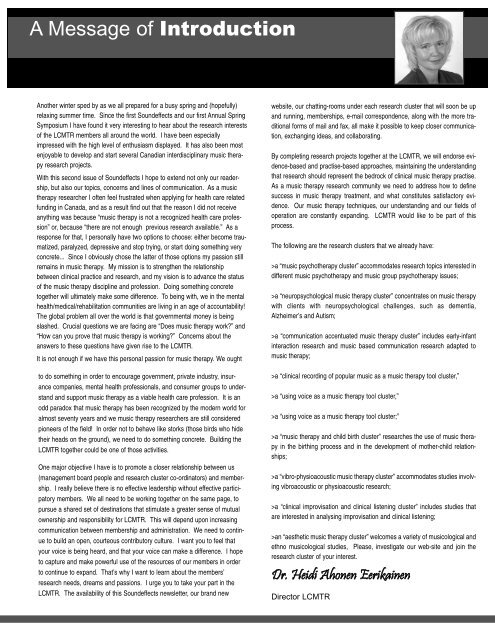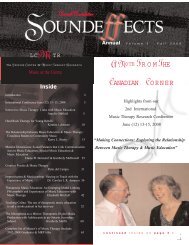Newsletter - Manfred and Penny Conrad Institute for Music Therapy ...
Newsletter - Manfred and Penny Conrad Institute for Music Therapy ...
Newsletter - Manfred and Penny Conrad Institute for Music Therapy ...
- No tags were found...
You also want an ePaper? Increase the reach of your titles
YUMPU automatically turns print PDFs into web optimized ePapers that Google loves.
A Message of Introduction22Another winter sped by as we all prepared <strong>for</strong> a busy spring <strong>and</strong> (hopefully)relaxing summer time. Since the first Soundeffects <strong>and</strong> our first Annual SpringSymposium I have found it very interesting to hear about the research interestsof the LCMTR members all around the world. I have been especiallyimpressed with the high level of enthusiasm displayed. It has also been mostenjoyable to develop <strong>and</strong> start several Canadian interdisciplinary music therapyresearch projects.With this second issue of Soundeffects I hope to extend not only our readership,but also our topics, concerns <strong>and</strong> lines of communication. As a musictherapy researcher I often feel frustrated when applying <strong>for</strong> health care relatedfunding in Canada, <strong>and</strong> as a result find out that the reason I did not receiveanything was because “music therapy is not a recognized health care profession”or, because “there are not enough previous research available.” As aresponse <strong>for</strong> that, I personally have two options to choose: either become traumatized,paralyzed, depressive <strong>and</strong> stop trying, or start doing something veryconcrete... Since I obviously chose the latter of those options my passion stillremains in music therapy. My mission is to strengthen the relationshipbetween clinical practice <strong>and</strong> research, <strong>and</strong> my vision is to advance the statusof the music therapy discipline <strong>and</strong> profession. Doing something concretetogether will ultimately make some difference. To being with, we in the mentalhealth/medical/rehabilitation communities are living in an age of accountability!The global problem all over the world is that governmental money is beingslashed. Crucial questions we are facing are “Does music therapy work?” <strong>and</strong>“How can you prove that music therapy is working?” Concerns about theanswers to these questions have given rise to the LCMTR.It is not enough if we have this personal passion <strong>for</strong> music therapy. We oughtto do something in order to encourage government, private industry, insurancecompanies, mental health professionals, <strong>and</strong> consumer groups to underst<strong>and</strong><strong>and</strong> support music therapy as a viable health care profession. It is anodd paradox that music therapy has been recognized by the modern world <strong>for</strong>almost seventy years <strong>and</strong> we music therapy researchers are still consideredpioneers of the field! In order not to behave like storks (those birds who hidetheir heads on the ground), we need to do something concrete. Building theLCMTR together could be one of those activities.One major objective I have is to promote a closer relationship between us(management board people <strong>and</strong> research cluster co-ordinators) <strong>and</strong> membership.I really believe there is no effective leadership without effective participatorymembers. We all need to be working together on the same page, topursue a shared set of destinations that stimulate a greater sense of mutualownership <strong>and</strong> responsibility <strong>for</strong> LCMTR. This will depend upon increasingcommunication between membership <strong>and</strong> administration. We need to continueto build an open, courteous contributory culture. I want you to feel thatyour voice is being heard, <strong>and</strong> that your voice can make a difference. I hopeto capture <strong>and</strong> make powerful use of the resources of our members in orderto continue to exp<strong>and</strong>. That’s why I want to learn about the members’research needs, dreams <strong>and</strong> passions. I urge you to take your part in theLCMTR. The availability of this Soundeffects newsletter, our br<strong>and</strong> newwebsite, our chatting-rooms under each research cluster that will soon be up<strong>and</strong> running, memberships, e-mail correspondence, along with the more traditional<strong>for</strong>ms of mail <strong>and</strong> fax, all make it possible to keep closer communication,exchanging ideas, <strong>and</strong> collaborating.By completing research projects together at the LCMTR, we will endorse evidence-based<strong>and</strong> practise-based approaches, maintaining the underst<strong>and</strong>ingthat research should represent the bedrock of clinical music therapy practise.As a music therapy research community we need to address how to definesuccess in music therapy treatment, <strong>and</strong> what constitutes satisfactory evidence.Our music therapy techniques, our underst<strong>and</strong>ing <strong>and</strong> our fields ofoperation are constantly exp<strong>and</strong>ing. LCMTR would like to be part of thisprocess.The following are the research clusters that we already have:>a “music psychotherapy cluster” accommodates research topics interested indifferent music psychotherapy <strong>and</strong> music group psychotherapy issues;>a “neuropsychological music therapy cluster” concentrates on music therapywith clients with neuropsychological challenges, such as dementia,Alzheimer’s <strong>and</strong> Autism;>a “communication accentuated music therapy cluster” includes early-infantinteraction research <strong>and</strong> music based communication research adapted tomusic therapy;>a “clinical recording of popular music as a music therapy tool cluster,”>a “using voice as a music therapy tool cluster,”>a “using voice as a music therapy tool cluster;”>a “music therapy <strong>and</strong> child birth cluster” researches the use of music therapyin the birthing process <strong>and</strong> in the development of mother-child relationships;>a “vibro-physioacoustic music therapy cluster” accommodates studies involvingvibroacoustic or physioacoustic research;>a “clinical improvisation <strong>and</strong> clinical listening cluster” includes studies thatare interested in analysing improvisation <strong>and</strong> clinical listening;>an “aesthetic music therapy cluster” welcomes a variety of musicological <strong>and</strong>ethno musicological studies, Please, investigate our web-site <strong>and</strong> join theresearch cluster of your interest.Dr. Heidi Ahonen EerikainenDirector LCMTR






